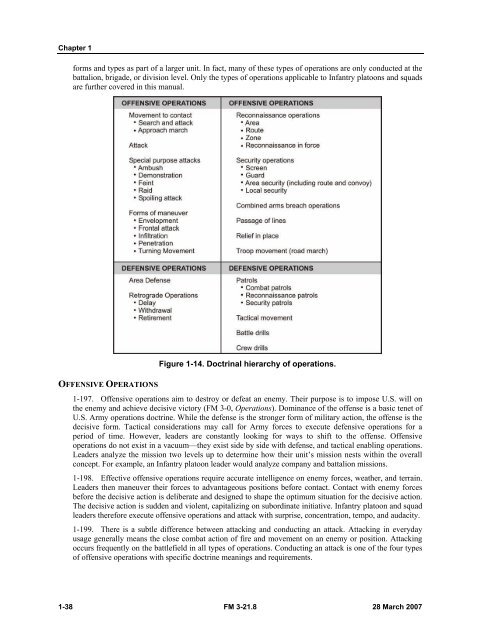Infantry Rifle Platoon and Squad - Sakai
Infantry Rifle Platoon and Squad - Sakai
Infantry Rifle Platoon and Squad - Sakai
Create successful ePaper yourself
Turn your PDF publications into a flip-book with our unique Google optimized e-Paper software.
Chapter 1<br />
forms <strong>and</strong> types as part of a larger unit. In fact, many of these types of operations are only conducted at the<br />
battalion, brigade, or division level. Only the types of operations applicable to <strong>Infantry</strong> platoons <strong>and</strong> squads<br />
are further covered in this manual.<br />
OFFENSIVE OPERATIONS<br />
Figure 1-14. Doctrinal hierarchy of operations.<br />
1-197. Offensive operations aim to destroy or defeat an enemy. Their purpose is to impose U.S. will on<br />
the enemy <strong>and</strong> achieve decisive victory (FM 3-0, Operations). Dominance of the offense is a basic tenet of<br />
U.S. Army operations doctrine. While the defense is the stronger form of military action, the offense is the<br />
decisive form. Tactical considerations may call for Army forces to execute defensive operations for a<br />
period of time. However, leaders are constantly looking for ways to shift to the offense. Offensive<br />
operations do not exist in a vacuum—they exist side by side with defense, <strong>and</strong> tactical enabling operations.<br />
Leaders analyze the mission two levels up to determine how their unit’s mission nests within the overall<br />
concept. For example, an <strong>Infantry</strong> platoon leader would analyze company <strong>and</strong> battalion missions.<br />
1-198. Effective offensive operations require accurate intelligence on enemy forces, weather, <strong>and</strong> terrain.<br />
Leaders then maneuver their forces to advantageous positions before contact. Contact with enemy forces<br />
before the decisive action is deliberate <strong>and</strong> designed to shape the optimum situation for the decisive action.<br />
The decisive action is sudden <strong>and</strong> violent, capitalizing on subordinate initiative. <strong>Infantry</strong> platoon <strong>and</strong> squad<br />
leaders therefore execute offensive operations <strong>and</strong> attack with surprise, concentration, tempo, <strong>and</strong> audacity.<br />
1-199. There is a subtle difference between attacking <strong>and</strong> conducting an attack. Attacking in everyday<br />
usage generally means the close combat action of fire <strong>and</strong> movement on an enemy or position. Attacking<br />
occurs frequently on the battlefield in all types of operations. Conducting an attack is one of the four types<br />
of offensive operations with specific doctrine meanings <strong>and</strong> requirements.<br />
1-38 FM 3-21.8 28 March 2007

















